David's Astronomy Pages
CCD Image Notes - Session 98
(2005-10-08)
Notes
(S97)
Notes
(Main)
Home
Page
Notes
(S99)
David's Astronomy Pages
|
Notes (S97) |
Notes (Main) |
Home Page |
Notes (S99) |
Notes from CCD Session 98 (S00098) Sky Condition Graph RR Lyrae Photometric Analysis Session QC - Zero Point Changes / Dew-Condensation Signature Refocusing Issues >
| Sky Conditions Chart (S98) |
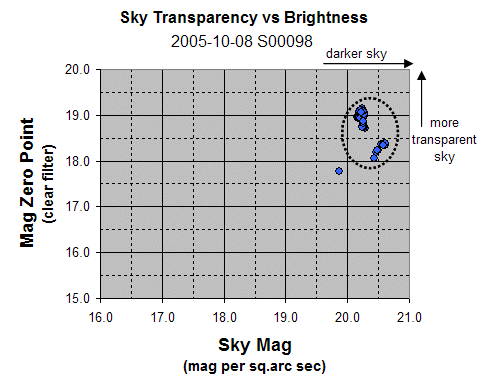
|
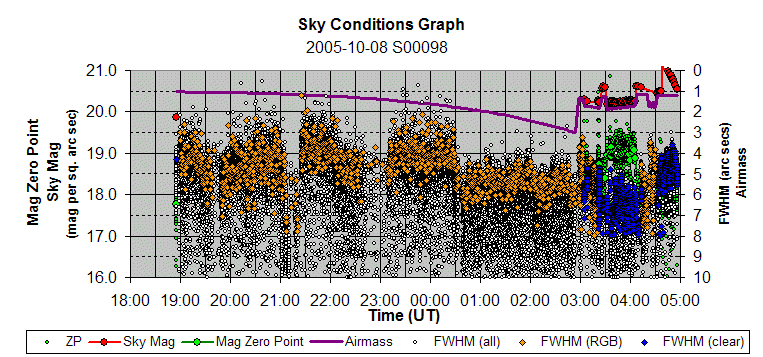
|
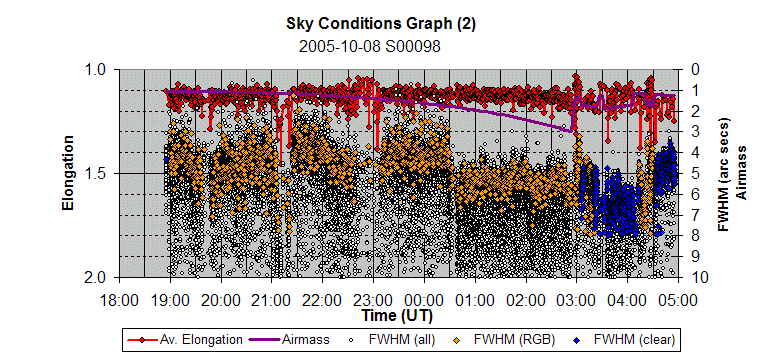
|
|
Notice
|
Back to Top
The main part of session 98 examined the
variation in RR Lyrae over an 8 hour interval, during which 516 images were
taken in each of B and V filters. The comparison star method was used to
produce calibrated magnitude estimates for the variable. The following
plot shows the distinct brightening of RR Lyrae over an interval of less than
2 hours, with gradual dimming thereafter.
| Data / Data QC |
|
Calibrated V mag and B Mag data are plotted against time in
the graphs below, along with control star magnitude (shifted to fit on
graph). Zero Point values determined from reference star measurements that
lie above a threshold level are used to distinguish higher quality data.
Analysis of QC Plots below show that the RR Lyrae brightening is real (far greater than variation in control star brightness). Quality of magnitude data is unfortunately slightly compromised around maximum brightness due to temporary formation of dew on the front lens of the LX200 scope. |
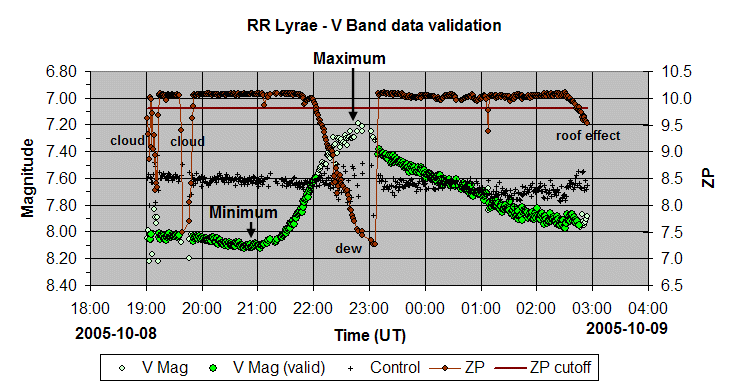
|
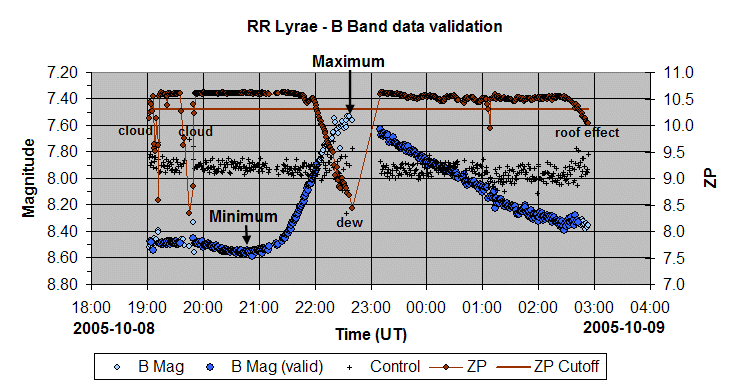
|
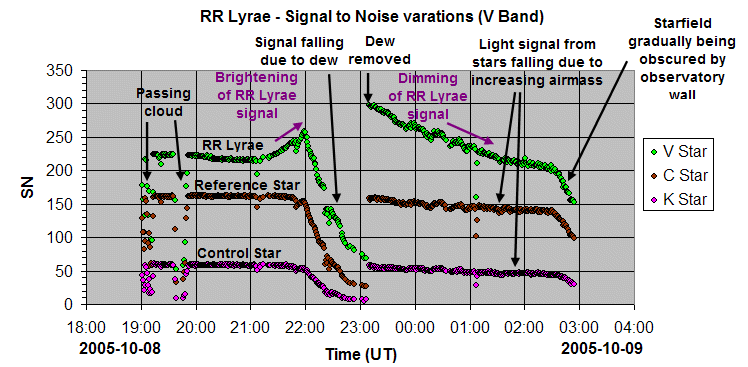
|
| Magnitude Data (B & V Filters) |
| V mag, B mag and B-V data is plotted here against time. The high quality data points (passing QC) are highlighted. |
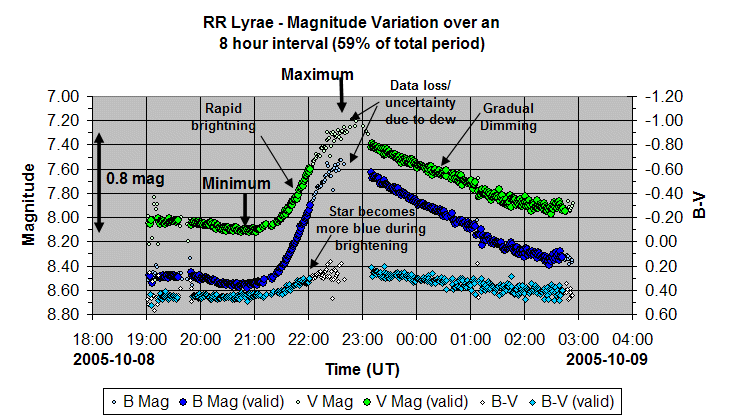
|
| Magnitude / Colour Analysis including comparison with previous sessions |
| V mag and B-V data was combined with data from previous sessions & plotted against phase, assuming the catalog period length for RR Lyr. |
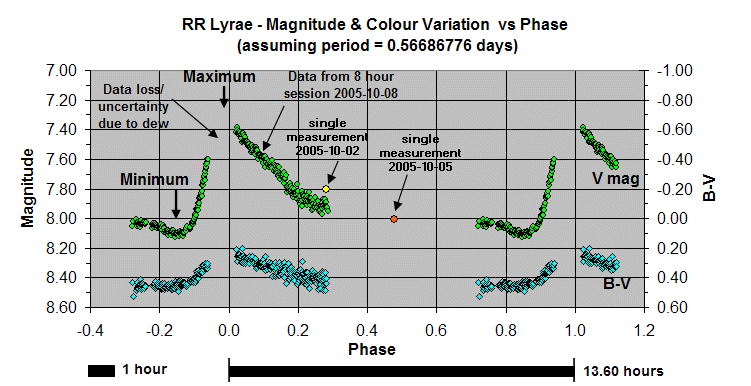
|
Back to Top
Magnitude zero points are essentially the values that need to be added to instrumental magnitudes to give actual magnitudes. The value will change with increasing airmass and with changes to the transparency of the atmosphere (changes from night to night, with developing cloud/weather).
During the 8 hour automated imaging of RR Lyrae, a routine visit to the observatory showed that faint stars where no longer visible on raw images and checking showed that condensation had developed on the front lens of the LX200. (The dew heater was on/ but the dew shield had been removed earlier to reduce wind vibration). The condensation was cleared with a hair dyer, the dew shield reinstalled and the session continued. Subsequent analysis of the V Band Images showing a distinct signature showing that levels of starlight reaching the CCD camera had been steadily falling for approximately 1 hour. That this was due to dew/condensation is very clear, because of the restoration of previous starlight levels once the hair dyer had been used to clear the dew.
Other features evident in the graph below are the occasional passing cloud near the start of the session, the falling levels of starlight due to the increasing airmass as the starfield descended in to lower altitudes, and the impact of the gradual obscuring of the starfield by the observatory wall. This isn't sharp because the top of the telescope's 8" diameter view still sees the star, whilst the lower half of the telescope view begins to see the observatory wall.
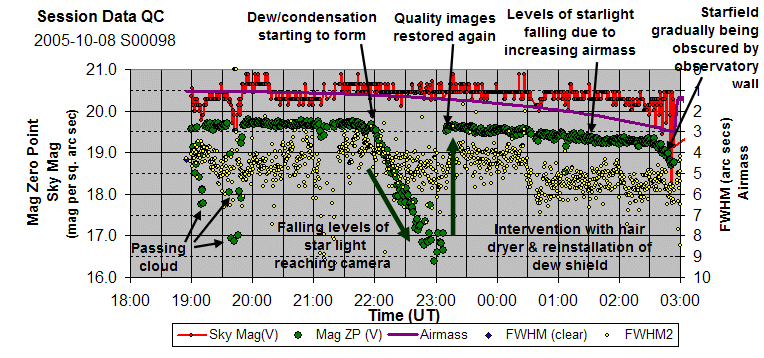
|
The impact of falling star light signal on S/N ratio is shown in the attached plot

With the new evidence showing impact of dew it is evident that part of a previous interpretation of thin cloud/haze developing between 00:50 and 01:20h UT on 2005-08-08 reducing sky transparency for images of HD209458, was more likely due to dew formation on the front lens of the LX200. (2005-08-08 notes)
| Data Plots from 2005-08-08 Session 91 |
|
|
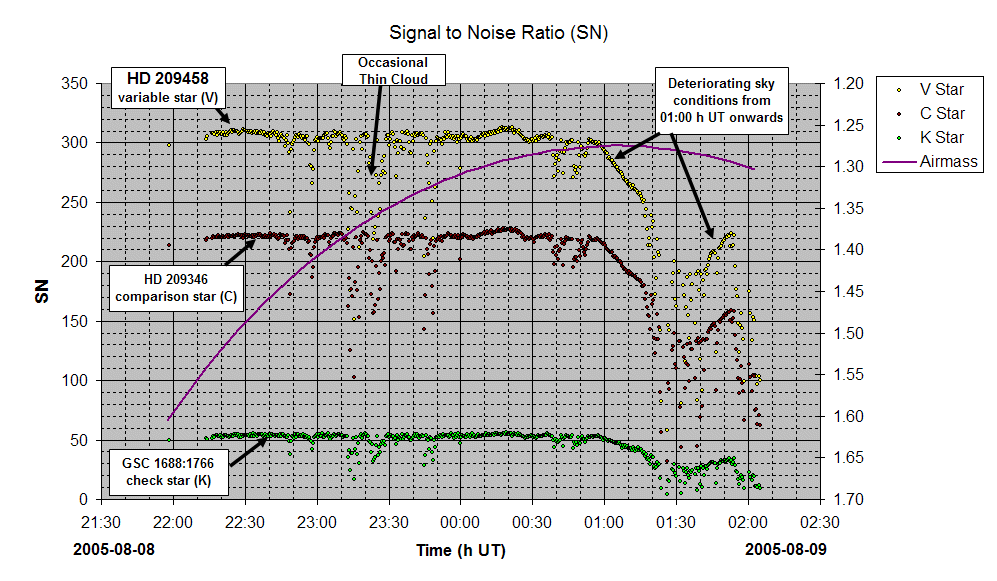
|
Back to Top
By means of Direct Read-Out of Star FWHM during fine focusing, I've had the means to quantify focusing (I have a JMI NGF-S focuser)., and a recent software modification allows me to pause and take direct FWHM read-out shots on selected stars. However an examination of the FWHM plot from this session ( 2005-10-08), shows that the FWHM values for acquired images takes some noticeable jumps, particularly the distinct 'backward' step at just after 00:30h UT.
The plot below shows these FWHM jumps along with
the times of refocusing attempts. This indicates that the 'backward' step
appears to have been caused by a bad (and as it is seems unnecessary) attempt at
trying to improve focusing at 00:34h UT.
Other refocusing points have had more or equally poor success. Reason for this
is not absolutely clear. I may examine other alternative means / strategy for
refocusing in future.
|
|
Back to Top
| This Web Page: | CCD Image Notes - (2005-10-08) |
| Last Updated : | 2015-05-16 |
| Site Owner : | David Richards |
| Home Page : | David's Astronomy Web Site |